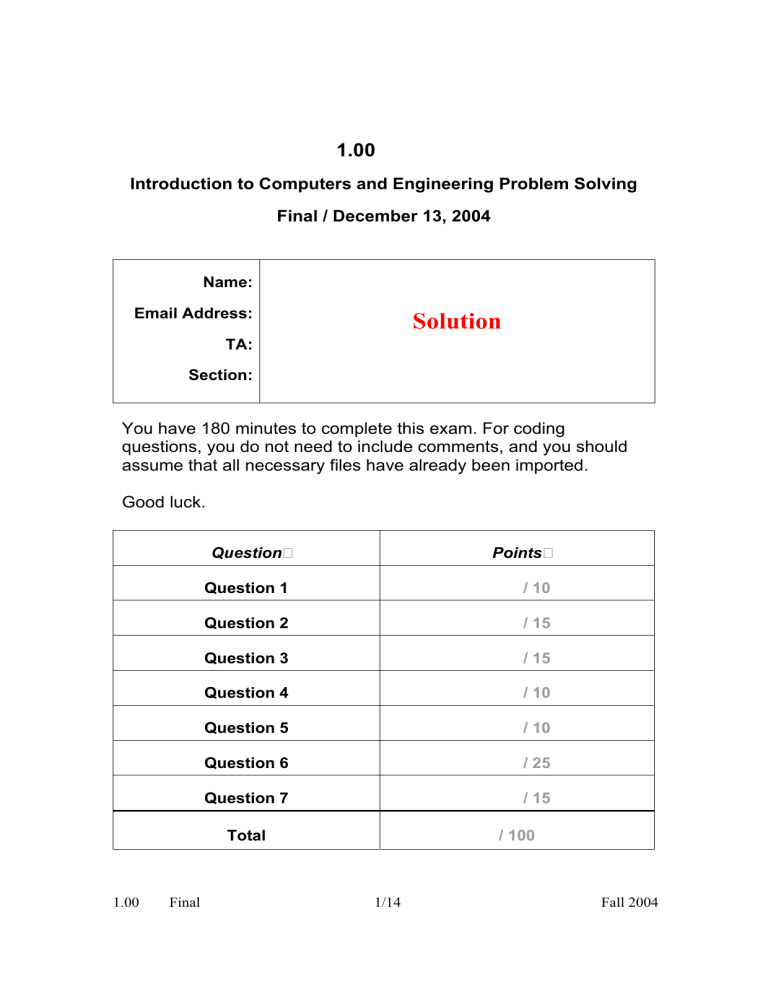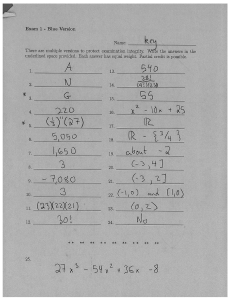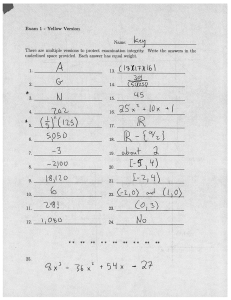Document 11591969

1.00
Introduction to Computers and Engineering Problem Solving
Final / December 13, 2004
Name:
Email Address:
TA:
Section:
Solution
You have 180 minutes to complete this exam. For coding questions, you do not need to include comments, and you should assume that all necessary files have already been imported.
Good luck.
Question
Question 1
Question 2
Question 3
Question 4
Question 5
Question 6
Question 7
Total
Points
/ 10
/ 15
/ 15
/ 10
/ 10
/ 25
/ 15
/ 100
1.00
Final 1/14 Fall 2004
Question 1. True / False + Multiple Choice + Short Answer (10 Points)
1. Every node in a Binary Tree must have 2 children.
TRUE FALSE
2. A single stream can be used as both an input stream and an output stream.
TRUE FALSE
3. There can be several catch blocks in a single try/catch structure.
TRUE FALSE
4. A method can throw more than one class of Exception .
TRUE FALSE
5. The following Java source code will compile. public class FinalExam
{ private int a; public static int printA()
{
System.out.println(“a = “ + a);
}
}
TRUE FALSE
6. An iterator of a HashMap visits its elements in the order they are inserted.
TRUE FALSE
7. Consider a HashTable that does not have any collisions. Suppose there are n
items to be stored and m
slots in the HashTable . Searching for an element in the
HashTable is: a.
O
( n
) b.
O
(1 ) c.
O
( m
) d.
O
( log n
)
1.00
Final 2/14 Fall 2004
8. Consider following Java method. public static void findOrder(int n)
{ int result = 0; for (int i = 0; i < n; i++)
{ for(int j = i; j < n; j++)
{ result++;
}
}
}
The above code runs in: a.
O
( n
) b.
O
(1) c.
O
( n 2
) d.
O
( log n
)
9. Consider an instance of data structure illustrated below. It has an add() method to add an element and remove() method to remove an element. The figure below shows an example of this data structure (referred to as d ) initially, after d.add(3) is called, and after d.remove() is called.
2 1 d.add(3)
3 2 1
3 2 d.remove()
Which type of data structure best describes this data structure?
STACK QUEUE
1.00
Final 3/14 Fall 2004
10. Consider following Binary Search Tree.
18
11
4
7 16 19
8 12 17
25
27
32
33 a. What’s the First Key of this Binary Search Tree?
Node 4 b. If node 11 was to be deleted from the tree, which node would be the successor that replaces node 11?
Node 12
1.00
Final 4/14 Fall 2004
Question 2. LinkedList (15 Points)
In this question, you are going to write a static method, findAverage() , which takes an instance of the Java Collections Framework LinkedList class that holds only
Integer objects and finds the average of contained Integer values. Here is the method signature: public static double findAverage(LinkedList list)
For instance, let’s suppose you have a LinkedList object that contains Integer(4) ,
Integer(6) , Integer(3) , Integer(2) , Integer(5) , and Integer(4) . The findAverage() method should find the average of the contained six Integer values (4.0 in this case) and return it.
Complete the findAverage() method. Assume that only Integer objects are contained in the LinkedList object. Your solution must use the ListIterator object to traverse the instance of LinkedList . public static double findAverage(LinkedList list)
{
ListIterator iter = list.listIterator();
// Your Code Here double sum = 0.0;
{
} return sum / list.size();
}
1.00
Final 5/14 Fall 2004
Question 3. Stack (15 Points)
In this question, you are going to write a static method, removeInteger() , which removes certain Integer object/objects from a stack. This method takes as arguments an instance of IntegerStack , which is a stack data structure specialized for
Integer objects, and an Integer object that specifies the value of the Integer objects you want to remove from the stack. Here is the method signature: public static void removeInteger(IntegerStack s, Integer i)
For instance, let’s suppose you have a variable IntegerStack s , which refers to the instance of IntegerStack that contains several Integer objects, and you would like to remove all the Integer objects that contain int value of 4.
2
4
1
4
3
2 removeInteger(s, new Integer(4)) 3
2
2
1
Original
Stack
Modified
Stack
As you can see from the diagram above, after invoking the removeInteger() method, the instance of IntegerStack no longer contains any instances of the Integer(4) object.
To complete the method, you need to use some of the following public methods of
IntegerStack class: x public IntegerStack() x public void push(Integer i)
1.00
Final 6/14 Fall 2004
x public Integer pop() throws EmptyStackException x public int size() x public boolean isEmpty()
Complete the removeInteger() method. public static void removeInteger(IntegerStack s, Integer i)
{
IntegerStack temp = new IntegerStack();
{
Integer current = s.pop();
{
temp.push(current);
}
}
{ s.push(temp.pop());
}
}
1.00
Final 7/14 Fall 2004
Question 4. Stream (10 Points)
In Streams lecture, we discussed three types of data formats that you can use to read and write information: text , binary data , and object . For a Java application that generates output data and distributes that data over the Internet, which data format would you use?
Why?
When an application distributes data over the Internet, the portability of the data is very important. That is, the data should be viewable / readable on different platforms or operating systems. Therefore, for the current problem, text format is the best choice.
1.00 Final 8/14 Fall 2004
Question 5. Tree (10 Points)
Consider the following tree.
X
2
+
6
3
/
X
2
2
Write the results from a Postfix (Post-Order), Prefix (Pre-Order), and Infix (In-Order) traversal for the above tree. Note that the nodes of above tree hold either numerical values or arithmetic operators, where the
X
denotes a multiplication operation.
Postfix (Post-Order) traversal: 2 6 3 2 X + 2 / X
Prefix (Pre-Order) traversal: X 2 / + 6 X 3 2 2
Infix (In-Order) traversal: 2 X 6 + 3 X 2 / 2
1.00 Final 9/14 Fall 2004
Question 6. Streams (25 Points)
Read the following code carefully. x The class StudentData stores the students’ name and three exam grades for
1.00 students. Its toString() method returns a string of name and grades, each of them separated by the tab character. x The class StreamExample takes input and output file names as arguments to its constructor.
Its parseFile() method opens the input file for reading. It reads a line of information, calculates the average from the student’s three grades, and creates a StudentData object from that with the average as the final data item. The StudentData object is then stored in an ArrayList list .
Its writeFile() method opens the output file for writing. It uses the toString() method of StudentData to write information for each of the objects in the list. x The format of the input file is as shown in the example below:
Ana 80
David 99
Mary 89
Fedrick 79
Chris 78
Elena 59
70
89
40
49
67
98
60
98
60
78
56
78 x The format of the output file should be:
Ana 80.0 70.0 60.0 70.0
David 99.0 89.0 98.0 95.333
Mary 89.0
Fedrick 79.0
40.0
49.0
60.0
78.0
63.0
68.667
Chris 78.0 67.0 56.0 67.0
Elena 59.0 98.0 78.0 78.333 public class StudentData
{ private String name; private double[] data; public StudentData(String n, double[] m)
{
}
1.00 Final 10/14 Fall 2004
} public String toString()
{
// See Part 1 below
} public class StreamExample
{
String inFile, outFile;
ArrayList list = new ArrayList(); public StreamExample(String name1, String name2)
{
} public void parseFile()
{
// See Part 2 below
} public void writeFile()
{
// See Part 3 below
}
}
Part 1) Complete the toString() method of StudentData such that it creates a
String object that has the format shown for the output file above. public String toString()
{
String s = ""; s = s + name + "\t"; for (int i = 0; i < data.length; i++) s = s + data[i] + "\t"; return s;
}
1.00 Final 11/14 Fall 2004
Part 2) Complete the parseFile() method of StreamExample to read the input file.
The method should: x Open the file for reading x Read each line of data while more data exists x Using the StringTokenizer , break each line into 4 tokens: name, grade1, grade2, and grade3. Each student has exactly 3 grades, and you do not need to check for misformatted data. A StringTokenizer is much simpler than a
StreamTokenizer . The StringTokenizer method nextToken() will return the next token as a String whether it is a word or number. x For each student ,
calculate the average of his or her grades using grade1, grade2, and grade3
store the 3 grades and the average in a double array of 4 elements
create an object of type StudentData using name, grades, and average
add the object to the ArrayList list . public void parseFile() { try {
FileReader fReader = new FileReader(inFile);
BufferedReader reader = new BufferedReader(fReader);
String temp = reader.readLine(); while (temp != null) {
StringTokenizer tokenizer = new StringTokenizer(temp);
String name = tokenizer.nextToken();
// Your Code Here double[] m = new double[4]; m[0] = Double.parseDouble(tokenizer.nextToken()); m[3] = (m[0] + m[1] + m[2]) / 3.0;
StudentData s = new StudentData(name, m); list.add(s);
temp = reader.readLine();
} reader.close();
} catch (FileNotFoundException e) { /* Implementation hidden */ } catch (IOException e) { /* Implementation hidden */ }
}
1.00 Final 12/14 Fall 2004
Part 3) Complete the writeFile() method of StreamExample to write the data from the ArrayList list to the output file. The method should: x Open the file for writing x Loop over all the data in list to write each object data on a new line (refer to the format of the output file shown above). public void writeFile()
{ try
{
FileWriter fWriter = new FileWriter(outFile);
BufferedWriter writer = new BufferedWriter(fWriter);
// Your Code Here for (int i = 0; i < list.size(); i++)
{
StudentData s = (StudentData) list.get(i); writer.write(s.toString()); writer.newLine();
}
} writer.close();
} catch (IOException e) { /* Implementation hidden */ } catch (Exception e) { /* Implementation hidden */ }
1.00 Final 13/14 Fall 2004
Question 7. Hashing (15 Points)
Part 1) A 1.00 TA wants to store the data related to students in his class in a hash table.
Assume all students in the class get a loaner laptop and each loaner laptop has a unique serial number between 00 and 99. The TA wants to use the serial number of the loaner laptop of a student as the key to hash. Suppose the hash table that he wants to use has 20 slots and the maximum enrollment in the class is restricted to 15. What is the maximum load factor for the hash table?
Load factor = 15/20 = 0.75
Part 2) Suppose the TA decides to add the two digits comprising the key to find out the slot in the hashing table to put the student into. Suppose there are 6 students in the class with their loaner laptop serial numbers being 89, 82, 79, 34, 56, and 65. What slots are allotted in the hash table? Is there a collision?
2
3
Student
1
Key
89
82
79
Slot in table
17
10
16
4
5
6
34
56
65
7
11
11
There is a collision as the keys of both student 5 and student 6 hashes to 11.
Part 3) If the serial numbers of a loaner laptop are equally likely to have any value between 0 and 99, does this hashing scheme distribute the keys uniformly in slots?
Which slot is the least likely to face collision?
The proposed scheme does not hash the keys uniformly. For example a hash value of 11 is more likely than a hash value of 1, and thus the chance of collisions is more for the slot 11 than for slot 1.
A hash value of 19 is not possible at all (The maximum number that you can get by adding two digits is 18). Thus the slot 19 would always be empty. Also, only the key 00 can have a hash value of 0. Hence the slot 0 would also not have any collision. Similarly slot 18 would not have any collision. Thus slots 19, 0 and 18 would not have any collision.
1.00
Final 14/14 Fall 2004





